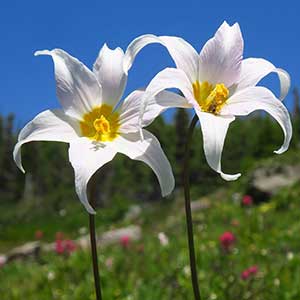Erythronium montanum
Erythronium americanum
avalanche-lily, white avalanche-lily, white glacier lily
American trout-lily, dogtooth violet, trout lily, yellow trout-lily, érythrone d'amérique
narrowly ovoid, 25–60 mm.
ovoid, 15–28 mm;
stolons 1–3, common, mostly on 1-leaved, nonflowering plants.
10–20 cm;
blade green, ovate to broadly lanceolate, base ± abruptly narrowed to petiole, margins wavy.
8–23 cm;
blade green, irregularly mottled, elliptic-lanceolate to ovate or elliptic, ± flat, glaucous, margins entire.
12–35 cm.
10–18 cm.
1–3-flowered.
1-flowered.
tepals white to creamy white with bright yellow zone at base, broadly ovate to broadly lanceolate, 25–45 mm, inner wider than outer, auriculate at base, length less than 4 times width;
stamens 12–24 mm;
filaments white, linear, slender, less than 0.8 mm wide;
anthers bright yellow;
style white, 13–25 mm;
stigma with slender, usually recurved lobes 1–5 mm.
tepals yellow, sometimes tinged light to dark purple-red abaxially, sometimes with reddish dots adaxially, strongly reflexed at anthesis, lanceolate, 20–33 mm, inner with small auricles;
stamens 9–15 mm;
filaments yellow, lanceolate;
anthers yellow, chestnut brown, or lavender;
pollen yellow or brown;
style deciduous or base forming small apiculum, greenish yellow, 5–11 mm, swollen distally or ± terete;
stigma lobes erect or recurved, 1.5 mm.
oblong, 3–6 cm.
held erect or at least off ground at maturity, obovoid, 12–15 mm, apex rounded, truncate, or apiculate.
= 24.
= 48.
Erythronium montanum
Erythronium americanum
This species occurs in the Coast Ranges of southern British Columbia, and disjunctly to southern Vancouver Island, the Olympic Peninsula, and Cascade Mountains from Mount Rainier National Park in Washington to central Oregon.
(Discussion copyrighted by Flora of North America; reprinted with permission.)
Varieties 2 (2 in the flora).
Erythronium americanum is a very common and widespread species, particularly in northeastern North America, becoming less frequent towards the southern and western limits of its range. Nonflowering plants far outnumber flowering ones in most populations because of their extensive stolon production. Plants with brown anthers have been called forma castaneum L. B. Smith.
(Discussion copyrighted by Flora of North America; reprinted with permission.)
1. Capsule apex rounded, truncate, or short-apiculate; stigma lobes erect, not grooved; widespread in ne United States | subsp. americanum |
1. Capsule apex distinctly apiculate; stigma lobes recurved, grooved distally; n Alabama, Georgia, ne Mississippi, Tennessee | subsp. harperi |


